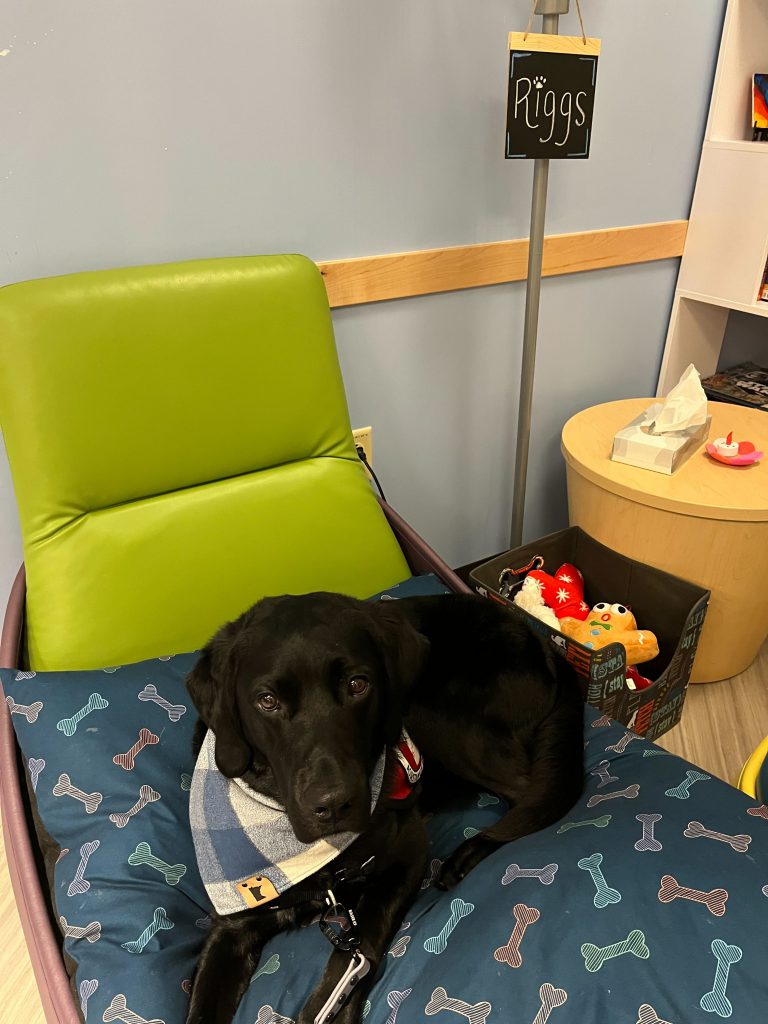Children’s Minnesota has a medical dog named Riggs, who joined the team in May 2023. He has been serving patients and families ever since!
Riggs currently works supporting patients at our St. Paul hospital alongside his handlers and child life specialists, Annika Kuelbs and Krista Majerus. While he does spread his time out to different care areas, Riggs spends a lot of time with our patients at the Center for the Treatment of Eating Disorders (CTED).
What is the Center for the Treatment of Eating Disorders at Children’s Minnesota?
Eating disorders can be complex. The Center for the Treatment of Eating Disorders is here to help your child resume healthy eating and return to a healthy weight. We’ll provide advanced treatment along with support and encouragement.
Eating disorders can affect the lives of patients in different ways — and can stem from different causes — which is why we’ve developed the skills to provide children, adolescents and adults with treatments that are tailored to a person’s individual situation.

Learn more about CTED, the conditions they help treat, what to expect and more.
What does Riggs do with patients in the Center for the Treatment of Eating Disorders?
While Riggs is one adorable pup, he does so much more than provide comfort and snuggles (which he does too!). Here are just a few ways Riggs helps our patients in CTED.
Mealtimes and post-meal encouragement
Riggs has his own chair in the CTED dining room and is present for some meals and post-meal observation times. He knows to stay in his spot until everyone is finished eating. Patients know once they are done with their meal, they have the option to go over to Riggs and snuggle.
Emotional regulation and de-escalation
Being a patient with an eating disorder can be difficult. Riggs has helped de-escalate and calm patients during difficult moments. To do so, a patient can place their hand on his side and breathe slowly in time with Riggs.
Cognitive and emotional processing
Another way Riggs can help CTED patients is simply through his presence. His presence can help patients and families talk more openly about their medical journey and emotions.
Preparation and procedural support
Being in the hospital can be hard, especially when you need a procedure that you may be nervous about, for example if a patient is nervous around needles. That’s where Riggs comes in. Riggs can be present to support patients who may be getting an IV or a nasogastric tube (NG tube) placed.
In addition, he provides comfort and support to patients while they are being prepped for their upcoming procedures or surgeries as well.
Developmental play & normalization
After meals, Riggs will often go to the Child Life Zone with the CTED group. In the Zone, patients are sometimes inspired to make him accessories or create Riggs-themed art.
Annika, Riggs’ handler, has also taught many CTED patients how to do tricks with Riggs, which can provide them with a sense of mastery and control.
What can I do if I think my child may have an eating disorder?
If you think your child has an eating disorder, talk to their primary care provider right away. They will have options and resources for you.
If you need additional resources, we gathered these easy-to-digest materials and resources from pediatric organizations in Minnesota and beyond to help.